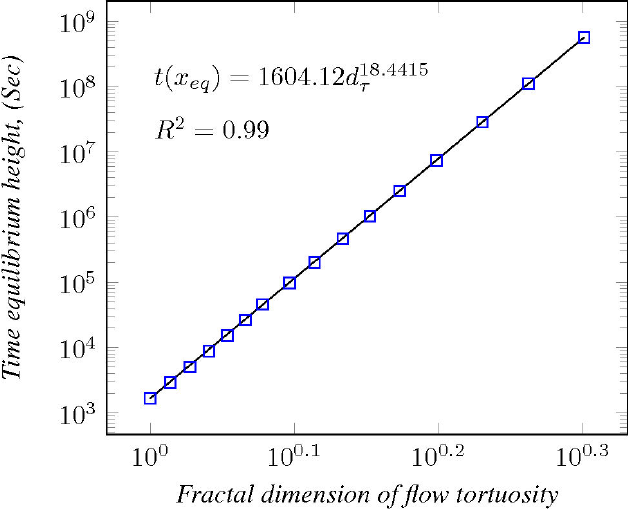PACS: 47.53-+n; 47.56.+r
1. Introduction
Spontaneous capillary imbibition is a transport phenomenon present in a variety of technological applications such as oil recovery, building materials, soil science, textile and hydrology1. Due to this diversity of applications, an infinity of theoretical2-6 and experimental7-14 studies have been carried out based on the pioneering works of Lucas15 and Washburn16 in order to understand the imbibition mechanism and the related phenomena (for review, see1,17,18, and references therein).
It was experimentally demonstrated that the imbibition speed becomes slower than that of Lucas-Washburn Regime
Li and Zhao19 added a fractal parameter to the classical model of spontaneous imbibition to describe the heterogeneity of the porous medium as
The objective of this work is to investigate the effects of the fractality in spontaneous imbibition processes on capillaries with paths similar to theoretical curves with exact fractal dimension.
The rest of the Letter is organized as follows. In Sec. 2 the mathematical tools needed in this paper were studied and defined. In Sec. 3 a new permeability parameter and an analytical model to describe the capillary rise by spontaneous imbibition on tubes with deterministic fractal geometry are established. In Sec. 4 an illustrative example in order to discuss some physical implications has been solved. In Sec. 5 the main findings and conclusions are outlined.
2. Basic tools in the fractal imbibition
In what follows, some basic concepts of fractal imbibition in highly tortuous capillaries are presented.
2.1. Governing equations in the Euclidean space
The governing equation of the liquid rise in a vertical capillary tube embedded in the Euclidean space E 1, when the capillary forces are dominant and the radius is very small, is given by a balance in the capillary, viscous and gravitational forces21,22, respectively represented as:
where
Liquid-air interface equilibrium height is defined as
When the gravitational forces can be considered very small, for example when the capillary tube is in the upright position and the penetration of the liquid
when the gravitational forces are included, integrating Eq. (2) with the initial conditions x = 0, t = 0, we get:
where
2.2. Governing equations in fractal space
The actual tortuous path of a flow in a porous medium is defined as
where
When
Differentiating Eq. (5) with respect to time t for a single capillary results in24:
where
When a wetting liquid is contacted with a tortuous capillary of any shape (Euclidean or Fractal), the capillary rise is described as5,16:
Substituting Eqs. (5) and (8) in (9) the following differential equation that governs the capillary rise in a tortuous capillary is obtained :
If the gravitational force is negligible, Eq. (10) is reduced to:
with the initial conditions x = 0, t = 0. Integration leads to Lucas-Washburn-Cai Equation5:
and when
3. Capillary rise on the linear fractals
Fractal propierties of capillary tubes with deterministic fractal geometries are obtained (see Fig. 2) for the first six iterations of each linear fractal including their fractal dimension,
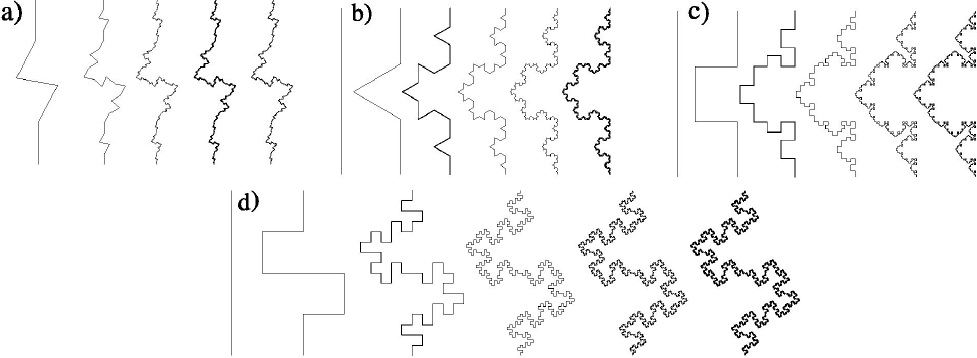
Figure 2 Capillary tubes with deterministic fractal geometries for first 6 iterations. a) Modified Koch curve27; b) Classic Koch curve; c) Carpintieri curve; d) Cuadratic Koch curve or “Minkowski sausage”.
Table I Properties of capillary tubes with deterministic fractal geometries, unitary porosity, constant diameter
| Parameter | Fractal curve | |||
| Koch | MKa | Carpintieri | Minkowski | |
| df | 001.261 | 001.161 | 001.340 | 0001.500 |
| dτ0 | 001.000 | 001.000 | 001.000 | 0001.000 |
| dτ1 | 001.025 | 001.020 | 001.036 | 0001.062 |
| dτ2 | 001.051 | 001.040 | 001.073 | 0001.125 |
| dτ3 | 001.077 | 001.060 | 001.109 | 0001.187 |
| dτ4 | 001.103 | 001.090 | 001.146 | 0001.250 |
| dτ5 | 001.129 | 001.100 | 001.183 | 0001.313 |
| xτ0 | 064.000 | 064.000 | 064.000 | 0064.000 |
| xτ1 | 085.330 | 080.000 | 096.000 | 0128.000 |
| xτ2 | 113.770 | 100.000 | 144.000 | 0256.000 |
| xτ3 | 151.703 | 125.000 | 216.000 | 0512.000 |
| xτ4 | 202.271 | 156.250 | 324.000 | 1024.000 |
| xτ5 | 269.695 | 195.310 | 486.000 | 2048.000 |
a Modified Koch curve.
The generalized permeability for a tortuous capillary tube is given by28-31:
However, the fractal approach to capillary cylinder permeability with fractal geometry is obtained inserting Eq. (5) in Eq. (13):
and for capillary tubes with unitary porosity,
It was shown that the equilibrium height
When
where
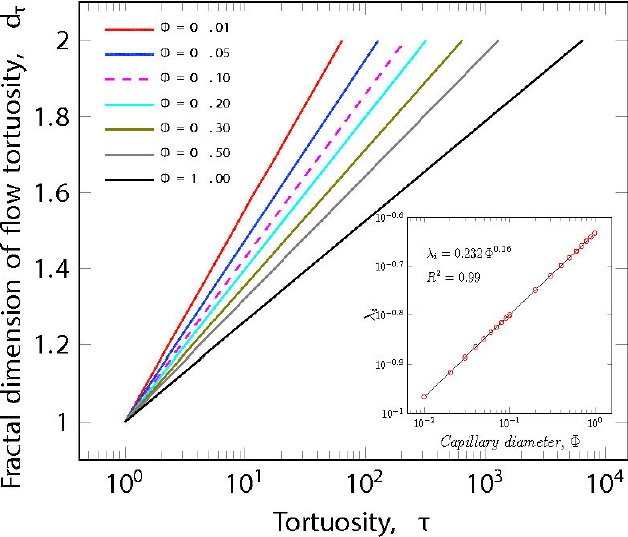
Figure 3 Semi-log plot τ vs. dτ for different capillary diameters of linear fractals with logarithmic fittings, where dτ = slope ln(τ) + 1 represented by straight lines. Dashed line shows a graph obtained from linear fractals (that is in agreement with Fig. 1 of Ref. 5. Insert shows data of Fig. 3 versus capillary diameter, fitted curve for linear regression analysis.
4. Example in Koch’s curve-like capillary tubes
In this section an illustrative example to clarify the physical implications of the introduced models is presented.
Consider a tortuous flow path, similar to a classic Koch curve, shown in Figure 1.b, with the following mechanical properties:
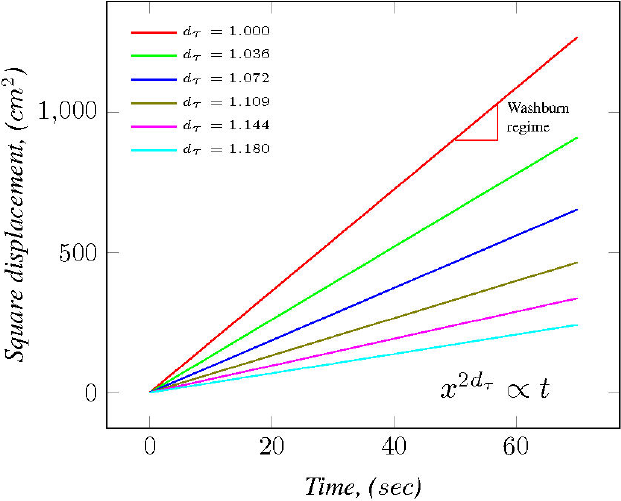
Figure 4 Comparison between the Euclidean case and fractal case in the first stage of imbibition. Graph shows Washburn Regime in Euclidean case (dτ = 1) while the fractal case (dτ > 1) evolves slower then the Washburn regime.
The flow behaviour in the second stage of imbibition, is obtained solving Eq. (15), where the equilibrium height is always the same and does not depend on the fractal dimension of the flow tortuosity (see Fig. 5). However, the time that fluid requires to reach the equilibrium height depends directly on
where
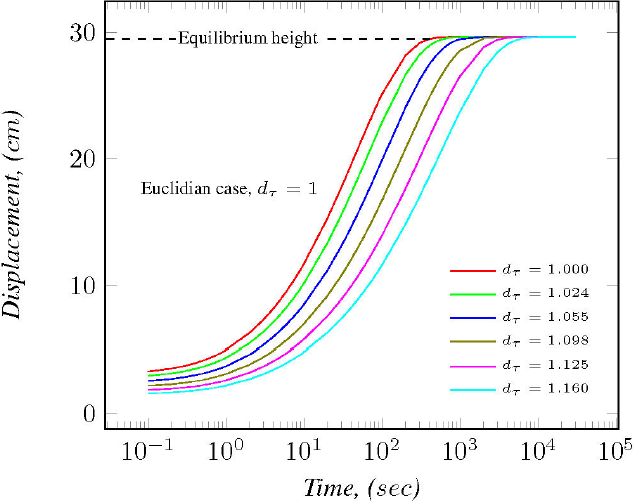
Figure 5 Comparison between Euclidean case and fractal case in the second stage of imbibition. Travel distance as function of time, for different iterations of the basic Koch’s curve-like capillary tube.
The previous results are common for ideal liquids, when the contact angle is equal to zero. The capillary rise is directly affected by the hydrostatic effect depending on the contact angle. This effect is calculated with the information of Fig. 4 according to Lucas-Washburn Eq. (3) and such effects are shown in Fig. 7. In an upcoming report the experimental results of fractal imbibition in tortuous Koch’s curves-like capillary tubes will be given.
5. Conclusions
In this paper the permeability relation for flow paths in capillary tubes with fractal geometry was generalized. This relation was used in Eq. (10) (Jian Chao Cai Equation) to describe the spontaneous fractal imbibition model given by Eq. (15). Also it was found that the fractal dimension of flow tortuosity increases, as the tortuosity and the capillary diameters of the cylinders increases, and does not depend on the fractal dimension of capillary tube (see Eq. (16)). An illustrative example of capillaries with the shape of linear fractal of Koch curve was presented. Results obtained are in agreement with the previously reported findings standard calculations and with the Lucas-Washburn-Cai equation, showing that as the fractality increases the penetration distance decreases. Finally, it was found that the necessary time to reach the equilibrium height of the tortuous capillary tube in the second stage of spontaneous imbibition is a function of the fractal dimension of flow tortuosity such that
This results provide a more detailed description of the physical phenomena of the spontaneous imbibition in linear fractal-like capillary tubes.











 text new page (beta)
text new page (beta)


